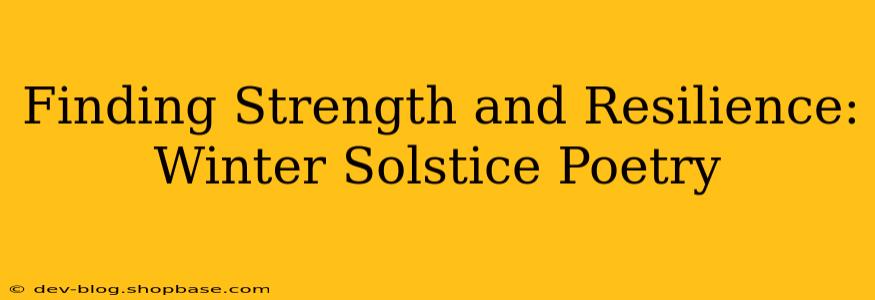The Winter Solstice, the shortest day of the year, marks a powerful turning point. It's a time often associated with darkness, cold, and dormancy, but beneath the surface lies a potent symbolism of resilience, hope, and the promise of rebirth. This is a time to reflect on the year past, acknowledge the challenges faced, and find inspiration in the poetic expressions of this profound moment. This exploration delves into the heart of Winter Solstice poetry, examining its themes and providing examples of its enduring power.
What is the significance of the Winter Solstice?
The Winter Solstice holds deep cultural and spiritual significance across numerous traditions. It's the astronomical event marking the official beginning of winter in the Northern Hemisphere, the point at which the sun reaches its lowest point in the sky. This seemingly bleak moment is, paradoxically, a pivotal point, signifying the sun's return and the promise of longer days ahead. For many, it's a time for introspection, reflection, and celebrating the cyclical nature of life, death, and rebirth.
What are some common themes explored in Winter Solstice poetry?
Winter Solstice poetry often grapples with themes that resonate with the season's symbolism:
-
Darkness and Light: The contrast between the darkness of the solstice night and the burgeoning light represents the struggle between despair and hope, the eventual triumph of light over darkness.
-
Renewal and Rebirth: The solstice is not an ending, but a transition. Poems often explore the idea of renewal, the promise of new beginnings after a period of dormancy and reflection.
-
Introspection and Reflection: The stillness and quiet of winter provide an opportunity for inward contemplation. Many poems delve into themes of self-discovery, personal growth, and acceptance.
-
Nature's Cycle: The seasonal changes are a central motif. The bare branches, frozen landscapes, and hibernating creatures all contribute to a powerful sense of cyclical renewal.
-
Resilience and Perseverance: The ability to endure hardship and emerge stronger is a common theme, echoing the plant life enduring the harsh winter months.
What are some examples of Winter Solstice poems?
While countless poems touch upon the themes of the Winter Solstice, finding specific poems explicitly titled "Winter Solstice Poem" is less common. However, many poems resonate with the spirit and symbolism of the solstice. Searching for poems focusing on winter imagery, themes of rebirth, and the cyclical nature of life will reveal numerous examples. Look for works by poets who frequently explore nature's rhythms and seasonal changes.
How can I write my own Winter Solstice poem?
Writing a Winter Solstice poem can be a deeply enriching experience. Consider these steps:
-
Reflect on your own experiences: How has this past year been? What challenges have you faced, and what lessons have you learned?
-
Observe your surroundings: Take note of the winter landscape – the colors, the textures, the sounds. Let the natural world inspire your imagery.
-
Embrace the symbolism: Explore the contrast between darkness and light, dormancy and rebirth.
-
Experiment with form and style: Don't feel limited to traditional forms. Let your creativity guide you.
What other holidays or events are celebrated around the Winter Solstice?
Many cultures celebrate festivals and holidays around the Winter Solstice, often incorporating similar themes of light, rebirth, and community. These include Yule (a pagan holiday), Christmas, Hanukkah, and Kwanzaa. These celebrations demonstrate the universal appeal of marking this significant turning point in the year.
How does the Winter Solstice affect different cultures?
The significance of the Winter Solstice varies across different cultures and spiritual beliefs. Some cultures view it as a time for introspection and spiritual renewal, while others celebrate it with feasts and festivals. The common thread remains the recognition of the cyclical nature of life and the promise of returning sunlight.
By exploring the richness of Winter Solstice poetry and reflecting on its themes, we can find strength and resilience in the face of winter's darkness, embracing the promise of renewal and the light that inevitably follows.

